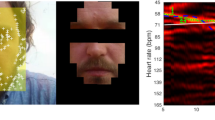Abstract
This paper presents a motion-based skin Region of Interest (ROI) detection method using a real-time connected component labeling algorithm to provide real-time and adaptive skin ROI detection in video images. Skin pixel segmentation in video images is a pre-processing step for face and hand gesture recognition, and motion is a cue for detecting foreground objects. We define skin ROIs as pixels of skin-like color where motion takes place. In the skin color estimation phase, RGB color histograms are utilized to define the skin color distribution and specify the threshold to segment skin-like regions. A parallel computed connected component labeling algorithm is also proposed to group the segmentation results into several clusters. If a cluster covers any motion pixel, this cluster is identified as a skin ROI. The method’s results for real images are shown, and its speed is evaluated for various parameters. This technology is compatible with monitoring systems, scene understanding, and natural user interfaces.










Similar content being viewed by others
References
Al-Tairi ZH, Rahmat RW, Saripan MI et al (2014) Skin segmentation using YUV and RGB color spaces. J Inf Process Syst 10(2):283–299
Appiah K, Hunter A, Dickinson P, Meng H (2010) Accelerated hardware video object segmentation: from foreground detection to connected components labeling. Comput Vis Image Underst 114(11):1282–1291
Dadgostar F, Sarrafzadeh A (2006) An adaptive real-time skin detector based on Hue thresholding: a comparison on two motion tracking methods. Pattern Recogn Lett 27(12):1342–1352
Ghadekar PP, Chopade NB (2014) Content based dynamic texture analysis and synthesis based on SPIHT with GPU. J Inf Process Syst 5(2):105–116
Hawick KA, Leist A, Playne DP (2010) Parallel graph component labelling with GPUs and CUDA. Parallel Comput 36(12):655–678
He L, Chao Y, Suzukic K et al (2009) Fast connected-component labeling. Pattern Recogn 42(9):1977–1987
Karavasilis V, Blekas K, Nikou C (2012) A novel framework for motion segmentation and tracking by clustering incomplete. Comput Vis Image Underst 116(11):1135–1148
Kawulok M, Kawulok J, Nalepa J (2014) Spatial-based skin detection using discriminative skin-presence features. Pattern Recogn Lett 41:3–13
Kim JB, Kim HJ (2003) Efficient region-based motion segmentation for a video monitoring system. Pattern Recogn Lett 24(1):113–128
Kumar A, Li B (2010) On implementing motion-based region of interest detection on multi-core CELL. Comput Vis Image Underst 114(11):1139–1151
Lim T, Han B, Han JH (2012) Modeling and segmentation of floating foreground and background in videos. Pattern Recogn 45(4):1696–1706
Lu J, Lafruit G, Catthoor F (2007) Fast reliable multi-scale motion region detection in video processing. IEEE International Conference on Acoustics, Speech and Signal Processing, pp.689–692
Medina-Carnicer R, Garrido-Castro JL, Collantes-Estevez E, Martinez-Galisteo A (2009) Fast detection of marker pixels in video-based motion capture systems. Pattern Recogn Lett 30(4):432–439
Naji SA, Zainuddin R, Jalab HA (2012) Skin segmentation based on multi pixel color clustering models. Digit Signal Process 22(6):933–940
Schmugge SJ, Jayaram S, Shin MC et al (2007) Objective evaluation of approaches of skin detection using ROC analysis. Comput Vis Image Underst 108(1):41–51
Sharif MH, Djeraba C (2009) Exceptional motion frames detection by means of spatiotemporal region of interest features. 16th IEEE International Conference on Image Processing, pp.981–984
Si W, Deng M, Xiao C (2009) Motion salient detection based on region-of-non-interest spatial-temporal analysis. International Conference on Information and Multimedia Technology, pp. 207–210
Song W, Cho S, Cho K et al (2014) Traversable ground surface segmentation and modeling for real-time mobile mapping. Int J Distrib Sens Netw. doi:10.1155/2014/795851
Stefanov N, Galata A, Hubbold R (2007) A real-time hand tracker using variable-length Markov models of behaviour. Comput Vis Image Underst 108(1):98–115
Vanus, Kucera P, Martinek R et al (2014) Development and testing of a visualization application software, implemented with wireless control system in smart home care, Human-centric. Comput Inf Sci 4(8)
Vintache D, Humbert B, Brasse D (2010) Iterative reconstruction for transmission tomography on GPU using Nvidia CUDA. Tsinghua Sci Technol 15(1):11–16
Xu S, Ye X, Wu Y et al (2008) Automatic skin decomposition based on single image. Comput Vis Image Underst 110(1):1–6
Yu Z, Mahabalagiri A, Velipasalar S (2013) Detection of moving people with mobile cameras by fast motion segmentation. 2013 Seventh International Conference on Distributed Smart Cameras, pp. 1–6
Acknowledgments
This research was supported by the MSIP(Ministry of Science, ICT and Future Planning), Korea, under the ITRC(Information Technology Research Center) support program (IITP-2015-H8501-15-1014) supervised by the IITP(Institute for Information & communications Technology Promotion), by Basic Science Research Program through the National Research Foundation of Korea (NRF) funded by the Ministry of Science, ICT and future Planning (NRF-2015R1A2A2A01003779), by Science and Technology Project of Beijing Municipal Education Commission (KM2015_10009006), and by the National Natural Science Foundation of China (61503005).
Author information
Authors and Affiliations
Corresponding author
Rights and permissions
About this article
Cite this article
Song, W., Wu, D., Xi, Y. et al. Motion-based skin region of interest detection with a real-time connected component labeling algorithm. Multimed Tools Appl 76, 11199–11214 (2017). https://doi.org/10.1007/s11042-015-3201-5
Received:
Revised:
Accepted:
Published:
Issue Date:
DOI: https://doi.org/10.1007/s11042-015-3201-5




